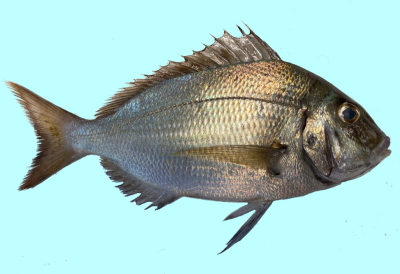Porgy recipes: Baked Porgy, Simmered Porgy, Fried Porgy, Broiled Porgy, Poached Porgy, Smoked Porgy
Porgy, sometimes called sea breams, is a common name for the members of the family Sparidae, known for a single dorsal fin, a small mouth, and very strong teeth that handle fishes and hard-shelled invertebrates like shellfish and crustaceans. Porgies are found in warm and tropical coastal areas and are especially abundant in the Mediterranean and Red seas and in the West Indies. Most species do not exceed 1 ft (30 cm) long, but some may grow to 4 ft (120 cm). Best known of the North American species is the migratory porgy, Pagrus pagrus, found from the Carolinas to Cape Cod and called scup in New England, porgy in New York, and fair maid in the South. Common of Chesapeake Bay is the sheepshead porgy. The jolthead porgy, named for its habit of butting shellfish loose from rocks and pilings, is the largest (up to 10 lb/4.5 kg) of the family. Of commercial importance in the area of the Gulf of Mexico is the pinfish (6-10 in./15-25 cm). In Europe the name porgy generally refers to the red porgy or sea bream, a red fish with blue spots common in Mediterranean and European Atlantic waters. The South African musselcrackers, popular sport fishes, grow to 100 lbs (45 kg). In Australia and Japan, several species of Chrysophrys are important food fish (called snappers in Australia).
There are about 15 species of porgy found in the western Atlantic and the Caribbean and more than 20 types in the Mediterranean and the eastern Atlantic, where they are known as sea bream. The most prized member of this family is the European Gilthead bream. They have firm, succulent flesh with excellent flavor. Gilthead bream weigh about 2 pounds and are always sold whole. Red sea bream are the only member of the family common in eastern Atlantic waters. Red sea bream meat is rosy when raw but turns white when cooked; it is moist with rich, sweet flavor and firm but tender texture. Scup live in coastal waters of the Atlantic Ocean between Cape Cod and Cape Hatteras, usualy sold in the marketplace as whole fish averaging 1 pound or less. They have delicious lean and flaky flesh, but also contain many bones, which makes them difficult to fillet. As a result, scup are generally cooked whole. They should be scaled and dressed before cooking, or large ones can be filleted. Simple preparations that complement scup's mild flavor are the best.
Red porgy are found on both sides of the Atlantic. Their flesh is firmer than that of other porgies, and the fish is also a bit larger and not as delicate as the gilt-head bream. Red porgy have white, tender meat with large flake and mild, sweet, but satisfying flavor, though its numerous small bones make it hard to fillet. Sheepshead porgy are found in the eastern Atlantic and the Caribbean. They have always been highly regarded as food and are pan-fried in the American South. The fat-bodied Northern porgy range from Cape Cod to the Carolinas and were widely abundant in New England. They have firm, flaky flesh, though it is quite bony. The plump, golden-silver jolthead porgy are delicious and beautiful and may be found along the North Carolina coast to Bermuda, the Bahamas, and the Caribbean.
Best Cooking:
Bake, broil, grill, poach, or sauté porgy. Sea bream are best cooked whole; they are traditionally added to bouillabaisse. Very fresh gilt-head and red bream may be used for sushi and sashimi. Red sea bream hass an excellent meat suited to poaching, stuffing, and baking. Red porgy works well as steaks or for stuffing and baking. Sheepshead porgy is the best for pan-fried. Scup or porgies are delicious when pan-fried, grilled, steamed, baked, broiled or even deep fried. After dressed porgies are cooked, the meat can be easily lifted free of the backbone just before serving if desired.Buying and Storing Tips:
Remember, the fishmonger's job is to sell fish. Trust is fine, but keep your eyes open.Trust your senses, first of all smell: A fresh fish won't smell fishy.
Look at the scales. Choose fish with bright, shiny scales. If the fish looks dull it's old.
Touch the fish. It should feel firm, not soft, and your fingertip shouldn't leave an impression.
Look the fish in the eyes. They should be clear and dark, as if it's looking back at you. No white at all.
Check the gills. They should be bright red.
Nor should most fish feel or look slimy.
Storage: Store whole fish in the refrigerator, surrounded by crushed ice, for 1 to 2 days after purchase or catch.
How to Fillet a Porgy:
Scale the fish if you plan on keeping the skin on. Staring at the tail, run the dull side of your knife backwards along the fish. Scraping the fish in short strokes, taking care to remove all the scales. If you plan on removing the skin, scaling isn’t necessary.Cut the fish behind the gills down to the backbone. Hold the knife towards the head at an angle to keep the most meat on the fillet.
Slide your knife down along the fish’s spine all the way to the tail. Take care to keep the knife as close to the backbone as possible to not waste any of the meat.
Lay the fillet skin side down on the table. To remove the skin, slide your knife between the meat and skin and work your knife back and forth until you reach the end of the fillet.
Place your knife under the ribs attached to the fillet. Cut the ribs off by sliding your knife under them and cutting them out from top to bottom. Use pliers to remove any remaining rib bones.
Rinse the fillets with clean water to remove any debris. Place them in a freezer bag and freeze if you will be storing them, or cook them immediately to get the most from the freshly filleted Grouper.
Nutrition Value:
Porgy, also known as sea bream or scup, is a lean fish with a coarse texture and delicate flavor, consisting of a large family of fish found in temperate and tropical waters all over the world. Porgy has a lot of small bones, so when selecting, it is best to buy larger specimens because they have a better meat to bone ratio, making the bones easier to remove.Nutritional Value Per Serving: For approximately 3.5 ounces of Porgy fish with bone, cooked: Calories 112, Calories From Fat 31, Total Fat 3.4g, Including (Saturated Fat 1.5g, Trans Fat 0.0g, Polyunsaturated Fat 0.8g., MonoUnsaturated Fat 1.1g), Cholesterol 12.0mg, Sodium 200mg, Total Carbohydrate 3g, Protein 19g.
Substitutes for Porgy:
Black Sea Bass, Red Snapper,Notes:
They are very important species in the sport and commercial fisheries of the USA, western Atlantic and the Caribbean, in the Mediterranean and the eastern Atlantic. They are also the prized species in Europe, Australia and Japan. The meat generates a fairly high price and is considered very good quality.Back to top
Fish Recepies



































